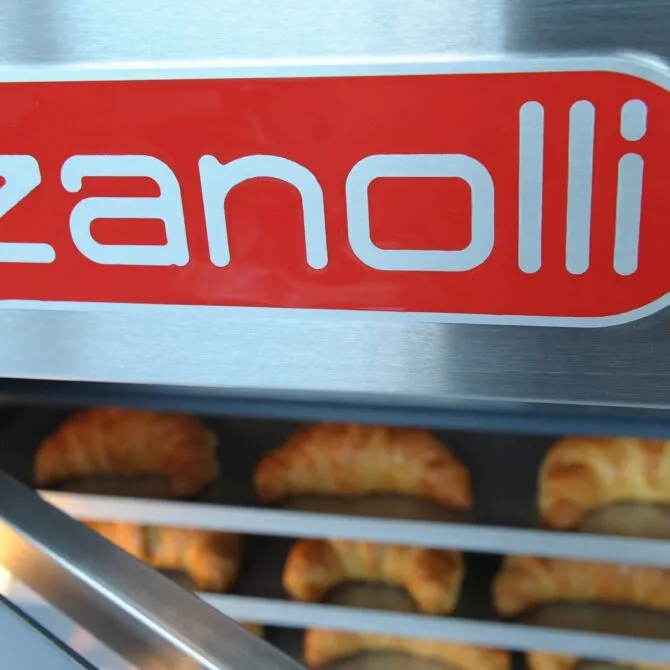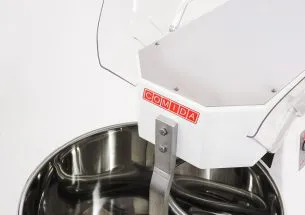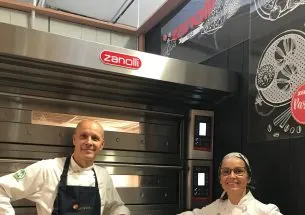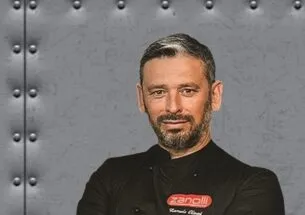Cooking is a process that transforms the food structure. To do so, it demands heat, therefore energy. Little wonder that one of the main expenditure items for bakeries, pizzerias and pastry shops is the consumption of cooking and refrigeration appliances. The first solution that comes to mind for reducing costs is to keep the electricity and gas supply to a minimum. However, in order to maximize the energy efficiency of the equipment, it is necessary to adopt a full-fledged strategy that includes a series of complementary measures. We’ll try to squeeze the essence of our 68 years’ experience into the following overview of practical tips for energy saving.
Power modulation
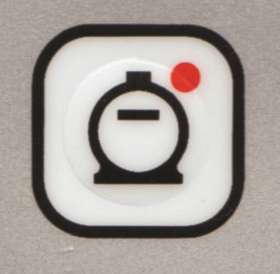 The Economy function in the Zanolli ovens is ideal for maintaining the right temperature in between cooking sessions. In the static ovens, the heating elements remain slightly heated to prevent the chamber from chilling down. In the Synthesis ventilated tunnel oven, the Economy button sets the oven to predefined parameters of temperature and conveyor speed. It is also possible to stop the conveyor completely, but this would cause a temperature gap between the part of the mesh that remains inside the oven and the external part. When there is no Economy button, in the case of static ovens, we recommend setting the power to 50% at the top and 30% at the bottom. In the case of convection ovens, such as Planet Gas and Ànemos, the adjustment is carried out by specific power regulators. When the oven is not in use, it is advisable to maintain it warm by lowering the temperature by 50% and keeping the door closed.
The Economy function in the Zanolli ovens is ideal for maintaining the right temperature in between cooking sessions. In the static ovens, the heating elements remain slightly heated to prevent the chamber from chilling down. In the Synthesis ventilated tunnel oven, the Economy button sets the oven to predefined parameters of temperature and conveyor speed. It is also possible to stop the conveyor completely, but this would cause a temperature gap between the part of the mesh that remains inside the oven and the external part. When there is no Economy button, in the case of static ovens, we recommend setting the power to 50% at the top and 30% at the bottom. In the case of convection ovens, such as Planet Gas and Ànemos, the adjustment is carried out by specific power regulators. When the oven is not in use, it is advisable to maintain it warm by lowering the temperature by 50% and keeping the door closed.
Production optimization
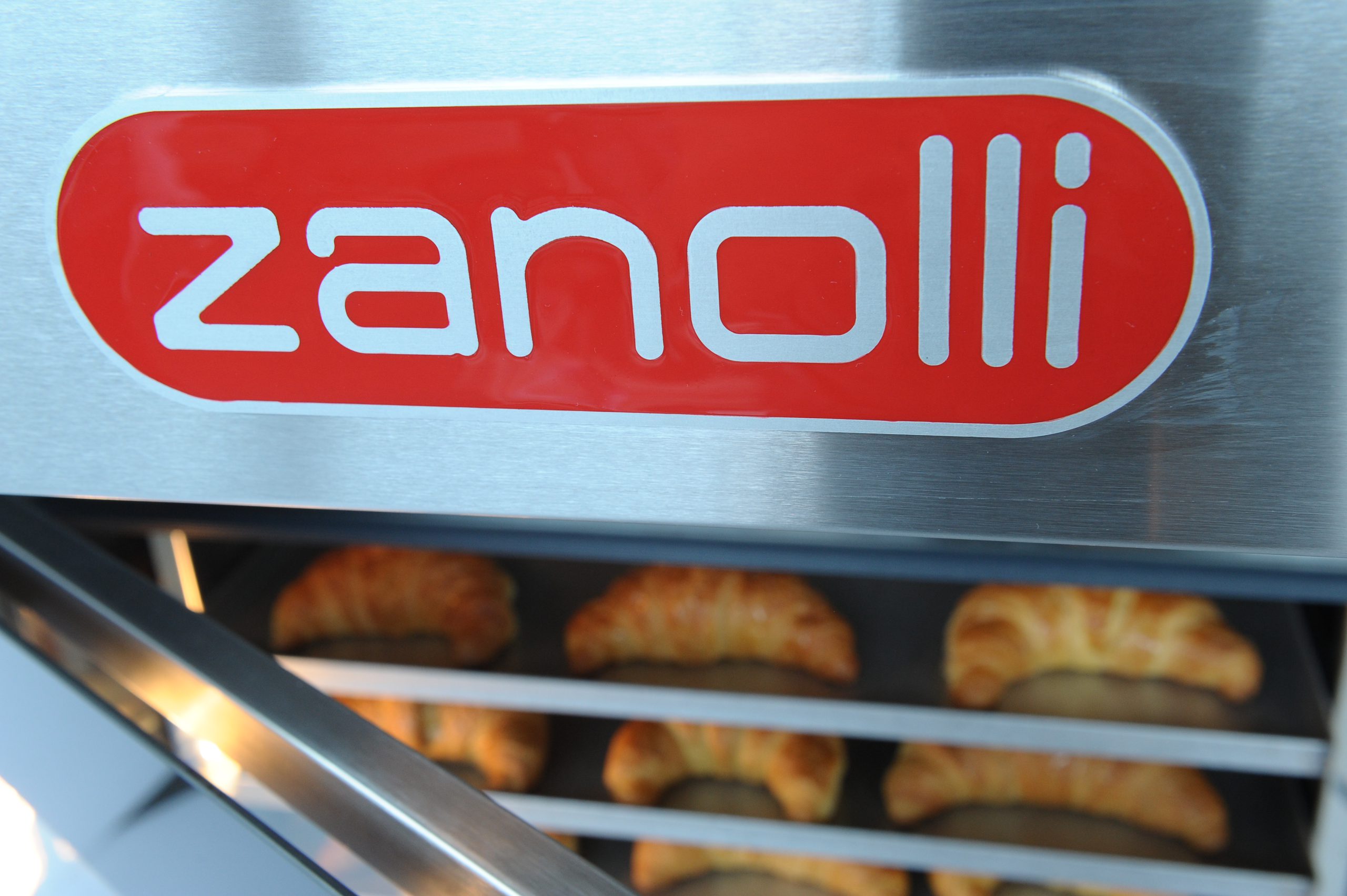 Many of the consumption-related problems can be solved beforehand, thanks to a rational planning of the cooking sessions. This may imply, for instance, the lowest possible number of different settings throughout the day, or at least a gradual and smooth transition. A regular distribution of the products on the baking surface is essential too: the more homogeneous the result, the lower the risk of having to cook some products again. Likewise, in order to reduce the number of cooking sessions per day, it is advisable to load the chamber as much as possible, even with different products provided they have similar cooking parameters. It goes without saying that the maximum capacity should not be exceeded. In a pizzeria, production is done on the spot and the inflow of customers is hard to predict. Statistical data can nonetheless help the pizza chef figure in advance how to best exploit the available cooking surface. The refractory material is very useful in maintaining the temperature. Where possible, we also recommend planning ‘shifts’ to allow the surface that has cooled beneath the pizza to recover some heat before placing the next pizza on top of it.
Many of the consumption-related problems can be solved beforehand, thanks to a rational planning of the cooking sessions. This may imply, for instance, the lowest possible number of different settings throughout the day, or at least a gradual and smooth transition. A regular distribution of the products on the baking surface is essential too: the more homogeneous the result, the lower the risk of having to cook some products again. Likewise, in order to reduce the number of cooking sessions per day, it is advisable to load the chamber as much as possible, even with different products provided they have similar cooking parameters. It goes without saying that the maximum capacity should not be exceeded. In a pizzeria, production is done on the spot and the inflow of customers is hard to predict. Statistical data can nonetheless help the pizza chef figure in advance how to best exploit the available cooking surface. The refractory material is very useful in maintaining the temperature. Where possible, we also recommend planning ‘shifts’ to allow the surface that has cooled beneath the pizza to recover some heat before placing the next pizza on top of it.
Insulation
Another great enemy of energy efficiency is the heat dissipation due to the natural cooling and accentuated while the oven’s door is open. To neutralize these effects, the Zanolli equipment is designed to ensure excellent insulation (optimized ventilation flows, double-glass doors, anti-dispersion systems by the doors). Insulation is even more effective if the ovens are properly arranged in the work environment: the air itself is an insulator, it is important to leave at least 20 spare centimeters around the oven to prevent it from overheating. Besides, equipping the oven with the suitable suction system can reduce the negative impact of external air currents. Always bear in mind that the temperature is also maintained by avoiding repeated openings.
Cleaning and maintenance
 The cost of regular maintenance, in terms of time and energy, is by far offset by the gain that a clean and properly functioning oven can guarantee in terms of efficiency. Keeping the equipment clean is one the best ways to counteract the natural wear and tear of the parts. Flour and other food residues should be removed on a regular basis, so as not to hinder the circulation of heat and air. A routine check-up can help spot anomalies and prevent damage. The longer your equipment lasts over time, the more you save!
The cost of regular maintenance, in terms of time and energy, is by far offset by the gain that a clean and properly functioning oven can guarantee in terms of efficiency. Keeping the equipment clean is one the best ways to counteract the natural wear and tear of the parts. Flour and other food residues should be removed on a regular basis, so as not to hinder the circulation of heat and air. A routine check-up can help spot anomalies and prevent damage. The longer your equipment lasts over time, the more you save!
Training and information
 Whether you are a reseller or an end user, don’t underestimate the importance of constantly upgrading your skills and expertise. This investment may prove to be particularly fruitful, especially if the acquired knowledge and good practices are shared among professionals in the sector, thus triggering a virtuous circle that benefits both the operators and the environment. For more insights and suggestions, you may contact the Zanolli commercial or technical department by filling our online form and visiting our page on training options.
Whether you are a reseller or an end user, don’t underestimate the importance of constantly upgrading your skills and expertise. This investment may prove to be particularly fruitful, especially if the acquired knowledge and good practices are shared among professionals in the sector, thus triggering a virtuous circle that benefits both the operators and the environment. For more insights and suggestions, you may contact the Zanolli commercial or technical department by filling our online form and visiting our page on training options.
Cooking is a process that transforms the food structure. To do so, it demands heat, therefore energy. Little wonder that one of the main expenditure items for bakeries, pizzerias and pastry shops is the consumption of cooking and refrigeration appliances. The first solution that comes to mind for reducing costs is to keep the electricity and gas supply to a minimum. However, in order to maximize the energy efficiency of the equipment, it is necessary to adopt a full-fledged strategy that includes a series of complementary measures. We’ll try to squeeze the essence of our 68 years’ experience into the following overview of practical tips for energy saving.
Power modulation
 The Economy function in the Zanolli ovens is ideal for maintaining the right temperature in between cooking sessions. In the static ovens, the heating elements remain slightly heated to prevent the chamber from chilling down. In the Synthesis ventilated tunnel oven, the Economy button sets the oven to predefined parameters of temperature and conveyor speed. It is also possible to stop the conveyor completely, but this would cause a temperature gap between the part of the mesh that remains inside the oven and the external part. When there is no Economy button, in the case of static ovens, we recommend setting the power to 50% at the top and 30% at the bottom. In the case of convection ovens, such as Planet Gas and Ànemos, the adjustment is carried out by specific power regulators. When the oven is not in use, it is advisable to maintain it warm by lowering the temperature by 50% and keeping the door closed.
The Economy function in the Zanolli ovens is ideal for maintaining the right temperature in between cooking sessions. In the static ovens, the heating elements remain slightly heated to prevent the chamber from chilling down. In the Synthesis ventilated tunnel oven, the Economy button sets the oven to predefined parameters of temperature and conveyor speed. It is also possible to stop the conveyor completely, but this would cause a temperature gap between the part of the mesh that remains inside the oven and the external part. When there is no Economy button, in the case of static ovens, we recommend setting the power to 50% at the top and 30% at the bottom. In the case of convection ovens, such as Planet Gas and Ànemos, the adjustment is carried out by specific power regulators. When the oven is not in use, it is advisable to maintain it warm by lowering the temperature by 50% and keeping the door closed.
Production optimization
 Many of the consumption-related problems can be solved beforehand, thanks to a rational planning of the cooking sessions. This may imply, for instance, the lowest possible number of different settings throughout the day, or at least a gradual and smooth transition. A regular distribution of the products on the baking surface is essential too: the more homogeneous the result, the lower the risk of having to cook some products again. Likewise, in order to reduce the number of cooking sessions per day, it is advisable to load the chamber as much as possible, even with different products provided they have similar cooking parameters. It goes without saying that the maximum capacity should not be exceeded. In a pizzeria, production is done on the spot and the inflow of customers is hard to predict. Statistical data can nonetheless help the pizza chef figure in advance how to best exploit the available cooking surface. The refractory material is very useful in maintaining the temperature. Where possible, we also recommend planning ‘shifts’ to allow the surface that has cooled beneath the pizza to recover some heat before placing the next pizza on top of it.
Many of the consumption-related problems can be solved beforehand, thanks to a rational planning of the cooking sessions. This may imply, for instance, the lowest possible number of different settings throughout the day, or at least a gradual and smooth transition. A regular distribution of the products on the baking surface is essential too: the more homogeneous the result, the lower the risk of having to cook some products again. Likewise, in order to reduce the number of cooking sessions per day, it is advisable to load the chamber as much as possible, even with different products provided they have similar cooking parameters. It goes without saying that the maximum capacity should not be exceeded. In a pizzeria, production is done on the spot and the inflow of customers is hard to predict. Statistical data can nonetheless help the pizza chef figure in advance how to best exploit the available cooking surface. The refractory material is very useful in maintaining the temperature. Where possible, we also recommend planning ‘shifts’ to allow the surface that has cooled beneath the pizza to recover some heat before placing the next pizza on top of it.
Insulation
Another great enemy of energy efficiency is the heat dissipation due to the natural cooling and accentuated while the oven’s door is open. To neutralize these effects, the Zanolli equipment is designed to ensure excellent insulation (optimized ventilation flows, double-glass doors, anti-dispersion systems by the doors). Insulation is even more effective if the ovens are properly arranged in the work environment: the air itself is an insulator, it is important to leave at least 20 spare centimeters around the oven to prevent it from overheating. Besides, equipping the oven with the suitable suction system can reduce the negative impact of external air currents. Always bear in mind that the temperature is also maintained by avoiding repeated openings.
Cleaning and maintenance
 The cost of regular maintenance, in terms of time and energy, is by far offset by the gain that a clean and properly functioning oven can guarantee in terms of efficiency. Keeping the equipment clean is one the best ways to counteract the natural wear and tear of the parts. Flour and other food residues should be removed on a regular basis, so as not to hinder the circulation of heat and air. A routine check-up can help spot anomalies and prevent damage. The longer your equipment lasts over time, the more you save!
The cost of regular maintenance, in terms of time and energy, is by far offset by the gain that a clean and properly functioning oven can guarantee in terms of efficiency. Keeping the equipment clean is one the best ways to counteract the natural wear and tear of the parts. Flour and other food residues should be removed on a regular basis, so as not to hinder the circulation of heat and air. A routine check-up can help spot anomalies and prevent damage. The longer your equipment lasts over time, the more you save!
Training and information
 Whether you are a reseller or an end user, don’t underestimate the importance of constantly upgrading your skills and expertise. This investment may prove to be particularly fruitful, especially if the acquired knowledge and good practices are shared among professionals in the sector, thus triggering a virtuous circle that benefits both the operators and the environment. For more insights and suggestions, you may contact the Zanolli commercial or technical department by filling our online form and visiting our page on training options.
Whether you are a reseller or an end user, don’t underestimate the importance of constantly upgrading your skills and expertise. This investment may prove to be particularly fruitful, especially if the acquired knowledge and good practices are shared among professionals in the sector, thus triggering a virtuous circle that benefits both the operators and the environment. For more insights and suggestions, you may contact the Zanolli commercial or technical department by filling our online form and visiting our page on training options.
You might also be interested in...

